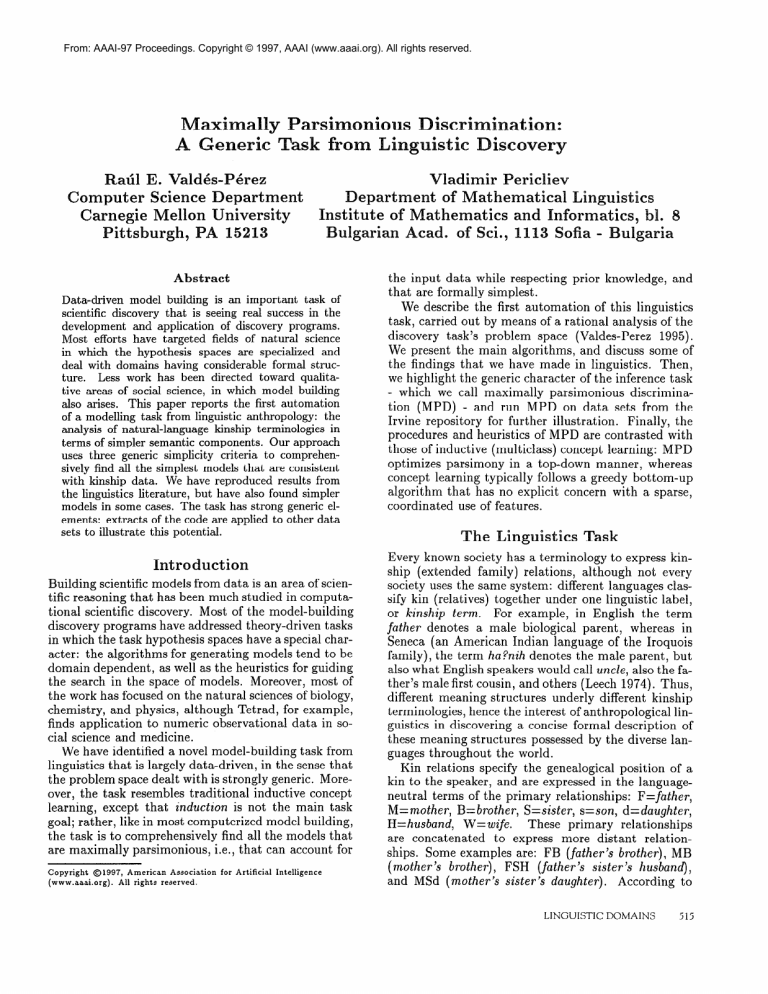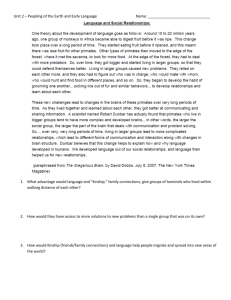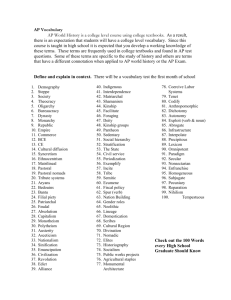
From: AAAI-97 Proceedings. Copyright © 1997, AAAI (www.aaai.org). All rights reserved.
Rallil
Computer
Ca
E. Vald&-P&ez
Science
epartment
Abstract
Data-driven
model
building
is an important
task of
scientific
discovery
that
is seeing
real success
in the
development
and application
of discovery
programs.
Most
efforts
have
targeted
fields
of natural
science
in which
the hypothesis
spaces
are specialized
and
deal with
domains
having
considerable
formal
strucLess work
has been
directed
toward
qualitature.
tive areas
of social
science,
in which
model
building
also arises.
This
paper
reports
the first
automation
of a modelling
task from
linguistic
anthropology:
the
analysis
of natural-language
kinship
terminologies
in
terms
of simpler
semantic
components.
Our approach
uses three
generic
simplicity
criteria
to comprehensively
find all the simplest
models
that are consistent
with
kinship
data.
We have reproduced
results
from
the linguistics
literature,
but have also found
simpler
models
in some cases.
The task has strong
generic
elements:
extracts
of the code are applied
to other
data
sets to illustrate
this potential.
Introduction
Building
scientific models from data is an area of scientific reasoning
that has been much studied in computational scientific discovery.
Most of the model-building
discovery programs
have addressed theory-driven
tasks
in which the task hypothesis
spaces have a special character: the algorithms
for generating
models tend to be
domain dependent,
as well as the heuristics
for guiding
the search in the space of models.
Moreover,
most of
the work has focused on the natural sciences of biology,
chemistry,
and physics, although
Tetrad, for example,
finds application
to numeric
observational
data in social science and medicine.
We have identified
a novel model-building
task from
linguistics
that is largely data-driven,
in the sense that
the problem
space dealt with is strongly
generic. Moreover, the task resembles traditional
inductive
concept
learning,
except that induction
is not the main task
goal; rather, like in most computerized
model building,
the task is to comprehensively
find all the models that
are maximally
parsimonious,
i.e., that can account for
Copyright
01997,
American
Association
(www.aaai.org).
All rights reserved.
for
Artificial
Intelligence
Vladimir
Pericliev
of Mathematical
Linguistics
athematics
and Informa
ad. of Ski., UP3 Sofia -
the input data while respecting
prior knowledge,
and
that are formally
simplest.
We describe the first automation
of this linguistics
task, carried out by means of a rational
analysis of the
discovery
task’s problem
space (Valdes-Perez
1995).
We present the main algorithms,
and discuss some of
the findings
that we have made in linguistics.
Then,
we highlight
the generic character
of the inference task
- which we call maximally
parsimonious
discrimination (MPD)
- and run MPD on data sets from the
Irvine repository
for further
illustration.
Finally,
the
procedures
and heuristics
of MPD are contrasted
with
those of inductive
(multiclass)
concept learning:
MPD
optimizes
parsimony
in a top-down
manner,
whereas
concept learning
typically
follows a greedy bottom-up
algorithm
that has no explicit
concern with a sparse,
coordinated
use of features.
The
Linguistics
Task
Every known society has a terminology
to express kinship (extended
family)
relations,
although
not every
society uses the same system: different
languages
classify kin (relatives)
together
under one linguistic
label,
or kinship
term.
For example,
in English
the term
father denotes
a male biological
parent,
whereas
in
Seneca (an American
Indian language
of the Iroquois
family),
the term ha?nih denotes the male parent, but
also what English speakers would call uncle, also the father’s male first cousin, and others (Leech 1974). Thus,
different
meaning
structures
underly
different
kinship
terminologies,
hence the interest of anthropological
linguistics in discovering
a concise formal description
of
these meaning
structures
possessed by the diverse languages throughout
the world.
Kin relations
specify the genealogical
position
of a
kin to the speaker, and are expressed in the languageneutral
terms of the primary
relationships:
F=fiather,
M=mother,
B=brother,
S=sister,
s=son, d=dcaughter,
H=husband,
W=wife.
These primary
relationships
are concatenated
to express more distant
relationships. Some examples
are: FB (father’s
brother),
MB
(mother’s
brother),
FSH (father’s
sister’s
husband),
and MSd (mother’s
sister’s daughter).
According
to
LINGUISTIC
DOMAINS
515
1.
3.
5.
7.
8.
9.
11.
13.
15.
16.
17.
18.
20.
22.
24.
26.
23.
29.
30.
32.
34.
great-grandfather
great-uncle
grandfather
uncle
aunt
father
son
brother
cousin
nephew
niece
grandson
great-grandson
husband
father-in-law
Bon-in-law
brother-in-law
sister-in-law
step-father
step-son
step-brother
great-grandmother
FFM,
FMM,
MFM,
MMM
2.
4.
great-aunt
RIMS, MFS, FMS, FFS
6.
grandmother
FM, MM
MMs, FSH, FSH, MSH, MSH, FFdH,
FMdH,
MMdH,
MFdH
MMd,
FBW,
FBW,
MBW,
MBW,
FFsW,
FMsW,
MMsW,
MFsW
10.
mother
M
12.
daughter
d
: Fs MS
14.
sister
S, Fd, Md
tiSd,‘MBd,
FSd, FBd, MSs, MBs, FSs, FBs, MMSdd,
MMSsd,
MMBdd,
MMBsd,
MFSsd,
MFBdd,
etc.
Bs, Ss, Fss, Mss, Fds, Mds, WSs, WBs, HSs, HBs, WMds,
WFss,
WFds,
WMss,
HMds,
HFss, HFds,
HMss
Bd, Sd, Fsd, Msd, Fdd, Mdd, WSd, WBd,
HSd, HBd, WMdd,
WFsd,
WFdd,
WMsd,
HMdd,
HFsd, HFdd,
granddaughter
dd,
sd
ss, ds
19.
ddd, ssd, sdd, dsd
sss, sds, dss, dds
21.
great-granddaughter
23.
wife
W
H
mother-in-law
WM, HM, WFW,
HFW
WF, HF. WMH,
HMH
25.
SW, WsW,
HsW
dH,‘WdI$
HdH’
27.
daughter-in-law
HB, WB, WMs,
WFs, HMs, HFs, WMHs,
WFWs,
HMHs,
HFWs,
SH, FdH, MdH, MHdH,
FWdH
HS, WS, WFd,
WMd,
HFd, HMd, WMHd,
WFWd,
HMHd,
HFWd,
BW, FsW,
MsW,
MHsW,
FWsW
MH
31.
step-mother
FW
33.
step-daughter
Hd, Wd
Hs, Ws
35.
step-sister
MHd, FWd
MHs, FWs
FFF, FMF,
MFF,
MMF
MMB,
MFB,
FMB, FFB
FF, MF
MB, FB, FFs, FMs, MFs,
MS, FS, FFd, FMd, MFd,
F
Table
1: Data
on English
linguistics
convention,
ego is the relative
from whom
the relationship
is traced (i.e., the speaker),
and alter
is the person to whom the kinship
term refers. Kinship terms normally
cover a set of several kin, e.g., the
English kinship
term cousin covers the kin-types
MSd
MBd FSd FBd MMSdd
MMSsd and many others. The
set of all kinship terms in a language forms the kinship
vocabulary
of this language.
In the science of linguistics, this vocabulary
constitutes
a semantic
(or lexical)
jield.
The task of the linguist
is to determine
the relevant semantic
features that can contrast
the meaning
of any of the kinship
terms within
the semantic
field
from any other kinship
term.
The disjunctive
listing
of kinship
examples
(e.g., consider
the many ways in
English to be a cousin) gets translated
into a conjunctive rule that covers all the input examples.
In general,
the task may involve inventing
new features in order to
better handle the problems
posed by a given language,
in addition
to finding
the conjunctive
rules, which together are called a componential
model in linguistics.
For over two decades componential
analysis has been
a valuable
tool in (anthropological)
linguistics
research
(Goodenough
1967; Leech 1974).
The criteria
for the quality
of this type of semantic modelling
are its consistency,
parsimony,
and comThat is, all kinship terms (heretofore,
prehensiveness.
kinterms
for short) should be mutually
discriminated
(if possible),
few features should be used and each kinterm description
should be as succinct as possible, and
the full set of alternative
simplest
models should be
considered.
Method
Table 1 lists extensive
data on English
kinship
first
compiled
by (Lounsbury
1964).
Our KINSHIP
program works directly
on such input,
but to illustrate
our approach,
we will analyze
a simplified
system of
only five kinterms:
son-in-law,
daughter-in-law,
sister,
516
LEARNING
Kinship
Terminology
iuncerm
son-in-law
daughter-in-law
sister
sister-in-law
father
Table
etc.
consangumaney
consanguine
affi;al
2: A Componential
generation
-1
-1
al
sex
m
f
0
0
1
Model
of Five Kinship
Terms
sister-in-law,
ancZ father.
A componential
analysis
might conclude
that the
simplest
model of the semantics
of these kinterms
is
as shown in Table 2. Only the three features
consanguinality
(blood relations
are called consanguineaz,
and
relations
by marriage
are afinal),
generation,
and se&
are needed. For example,
a sufficient
model for sisterin-law is afinal
and generation=0
meaning
that the
kinship relation
arises by marriage
of the speaker (ego)
and is considered
to be of the same generation.
Note
that it is not necessary
to specify that sister-in-law
is female, because the stated two-feature
description
is enough to contrast
sister-in-law
from the remaining
kinterms.
The right way to interpret
a consistent
componential
model like that in Table 2 is that no other kinterm possesses the conjunction
of feature values that describe
that kinterm.
Thus, no other kinterm
in the simplified
problem
being considered
has generation=f,
which is
the entire description
for father.
Let us now consider
how to arrive at the componential
model in Table 2 starting
from the raw data
in Table 1 on the five kinterms
and their individual
instances. The first step is to compute the feature values
of all the instances.
Currently
our KINSHIP
program
computes
20 features, all of specific relevance to genealogy and kinship,
some taken from the anthropological
and linguistics
literature.
The second step is to express the feature values for
each kinterm
as a function of the feature values of the
instances.
The rules for this function
are as follows. A
kinterm
is assigned
a single feature value if the feature is Boolean
and
all the instances
possess that value, otherwise
N/A.
a minimal
set of feature values if the feature is nominal and the value of every instance appears in the
set, otherwise
N/A.
e a range if the feature is numeric and all the instances’
values lie within the range (which is chosen to be the
smallest possible).
The Patter two rules, involving
a set of nominal
values
and a numeric
range, allow a degree of disjunctiveness
in formulating
the contrast
between two kinterms.
arsir~~~~y.
At this point the instance feature values have been transferred
to their parent
kinterms.
The next step is to set up a logical formula
that expresses the constraint
of pairwise
contrast:
for every
pair of kinterms,
form a disjunction
of all the features
that serve to cleanly
contrast
the pair.
In the case
of a Boolean feature,
a pair of kinterms
is contrasted
if their Boolean
values are unequal;
for numeric
and
nominal
features,
they are contrasted
if their ranges
and sets (respectively)
do not overlap.2
Then, the conjunction
of all these pairwise disjunctions
expresses (as
a conjunctive
normal form - CNF) the possible feature
sets that can cleanly
contrast
all the kinterms.
If a
pair cannot be contrasted,
then this is reported
and
the contribution
of that kinterm
pair to the CNF is
skipped, otherwise
the formula
would collapse into unsatisfiability.
The previous
system of five kinterms
gives rise to
the following
CNF formula,
which possesses 10 (5 kinterms, choose 2) conjuncts:
(and (or sex)
generation
consanguinality)
(or sex distance
(or sex generation)
generation
lineality
ancestor
(or distance
consanguinality
generation-of-last-link
structural-equivalence)
generation
consanguinality)
(or distance
(01 generation)
generation
lineality
(or sex distance
ancestor
generation-of-last-link
consanguinality
structural-equivalence)
consanguinality)
(or distance
lineality
(or sex generation
ancestor
generation-of-last-link)
generation
lineality
ancestor
(or sex distance
consanguinality
structural-equivalence))
For example,
the first conjunct
expresses the single
contrast
(sex) between son-in-Zaw and dazaghter-in-law;
20f course, a statistica%contrast
could be introduced
allowing a certain fraction of overlap.
by
the second conjunct
expresses four possible contrasts
between
son-in-law and sister, and so on. The subsequent conversion
of this CNF to disjunctive
normal
form (DNF) yields simply:
(or (and distance
generation
sex)
(and consanguinality
generation
sex))
which, of course, expresses the same meaning
as the
CNF formula,
but in a different
(DNF) form. The disjuncts of this DNF represent
all the possible subsets of
features that can explain the data. In this case, there
are two possible subsets, both of which are equally simple (contain
fewest features).
We will choose the second subset to continue
our example
(both would be
followed
up by the program).
This step illustrates
the
first of our three simplicity
criteria:
select a minimal.
feature set. All three simplicity
criteria
that we will
introduce
are applied by manipulating
logical formulas.
Given the set of available
features (following
our example, consanguinality, generation, and sex), the next
step is to express the possible descriptions
for each individual
kinterm.
For a given kinterm,
we compare
its feature
values with those of every other kinterm,
and form a CNF that expresses the possible contrasts,
much like before.
Table 3 shows these CNF formulas
for each individual
kinterm.
Table
3 also shows the DNF equivalents
of the
CNF formulas;
the corresponding
formulas
are exactly
equivalent
in logical meaning,
but the DNF is in the
form needed to apply our second
simplicity
criterion:
choose the smallest expression
for each kinterm,
i.e.,
having the fewest features.
For example,
father possesses two alternative
expressions,
one of which (generation) is simpler. Hence, the first alternative
for father
is discarded.
This criterion
is reminiscent
of preferring
the most general conjunctive
rule, except that here it
is unclear that a shorter rule is more general, because
the feature sets may not even intersect.
The descriptions
for three of the kinterms
are thus
determined;
the only remaining
source of variability
concerns
the two terms son-in-law and sister in Table 3. Both of these terms possess two equally
simple alternative
descriptions,
which implies a potential
for 2 x 2 = 4 alternative
full models.
The problem
of
choosing among these alternatives
motivates
our third
simplicity
criterion,
which seeks to impose a global coherence on the choices remaining
after the first two
criteria
have been applied.
We note that the two alternatives
for son-in-law both involve the feature sex,
so this feature
must appear;
the remaining
choices
for this kinterm
are captured
by the formula
(or
(and generation)
(and consanguinality)).
similarly, the two choices for sister both involve
consunguinality, so the remaining
alternatives
are captured
by the formula
(or (and sex) (and generation)).
Conjoining
these two choices and converting
the result
to DNF yields
(or (and generation)
(and consanguinality
sex))
from which the simplest
is just generation.
We now
go back to the choice points for son-in-law and sister
LINGUISTIC
DOMAINS
517
kinterm
CNF formula
sonin-law
‘(and
daughterin-law
(and
sister
(and
sisterin-law
(and
father
(and
(or
(or
(or
(or
(or
(or
(or
(or
(or
(or
(or
(or
(or
(or
(or
(or
Table
sex) (or consanguinality
generation
sex)
generation
sex)
consanguinality
generat ion) 1
sex) (or consanguinality
generat .on)
generat ion)
consanguinality
generation
sex) 1
consanguinality
generation
sex)
consanguinality
generat ion)
consanguinality)
(or generation
sex))
generation
sex) (or generation)
consanguinality)
consanguinality
generat ion sex) 1
consanguinality
generation)
consanguinality
generat ion sex)
generat ion sex) 1
consanguinality
generat ion sex) 1
3: CNF
Formulas
and DNF
Equivalents
and choose the description
[generation,
sex] for son-inZaur and [consanguinality,
generation]
for sister. Thus,
the four potential
descriptions
of the two kinterms
are
reduced to a single one by minimizing
the variability
in
these choices. This is accomplished
by setting up not a
CNF expression
as in the first two simplicity
criteria,
but rather
a conjunction
of DNF’s,
and this nested
expression
is converted
to a simple DNF to carry out
our third and final simplicity
criterion.
The final result
is the simplest
componential
model shown in Table 2;
specific feature values are included
for each kinterm.
We can now summarize
the effects of our three simplicity criteria.
The first serves to minimize
the set S
of features
that are used. Given a set S, the second
criterion
serves to minimize
the kinterm
descriptions
by using the fewest features
from S. There may still
remain alternatives,
so the third criterion
strives for a
global coherence
among these alternatives.
Even after
applying
these criteria,
there is no guarantee
that the
result is a unique most-parsimonious
model.
Domaindependent
criteria
could be introduced,
or all the alternative
simplest
models can simply be reported
to
the user.
Lack of space precludes
a more formal treatment
of
the algorithm
and its computational
complexity;
this
is left for future publications.
Linguistics
Results
We have applied MPD (in the form of the specialized
KINSHIP
program)
to substantially
complete data sets
on English
(35 kinterms)
and Bulgarian
(40 terms),
and to smaller data sets from the linguistics
literature
such as Hindi (30 terms), Polish (27 terms), Seneca (17
terms - consanguineal
only), and Swedish (23 terms).
In every case, the simplest
componential
models contain between 4 and 7 features out of the 20 that are currently available
in the program;
of course the specific
518
LEARNING
(or
(and
(and
DNF eativalent
generat ion sex)
consanguinality
sex) 1
(or
(and generat
ion sex) )
(or
(and consanguinality
(and consanguinality
sex)
generat
ion) )
ion) )
(or
(and
consanguinality
generat
(or
(and
(and
consanguinal
ity
generat ion) )
sex)
for Individual
Kinship
Terms
features vary across languages.
For some languages,
a
unique simplest model exists (e.g., English)
whereas for
others, there are multiple
models of equal simplicity.
This should not be hastily interpreted
as an inherent
characteristic
of a language,
because the possibility
of
a unique simplest model depends on the available
features and on their specific definitions
(there is some
variance of feature definitions
in linguistic
practice).
A companion
paper (Pericliev
& Valdes-Perez
1997)
for a linguistics
audience
describes
our linguistics
contributions,
which we summarize
here.
KINSHIP
has reproduced
Lounsbury’s
classic analysis of Seneca
(Leech 1974), successfully
analyzed
a previously
unanalyzed language
(Bulgarian),
and improved
on previous analyses of English.
The program
discovered
both
the most parsimonious
model of English,
and the only
one respecting
the requirement
that all kinterms
have
conjunctive
definitions
(half a dozen known analyses
have either tacitly ignored or artificially
circumscribed
this issue). Also, our task formalization
has handled
aspects that were previously
only implicit
(e.g., our
third simplicity
criterion
is based on an intuition
that
was never explicitly
formulated
in the literature).
Finally, we have shown mistakes in analyses performed
by human
analysts,
further
illustrating
the need for
computerized
tools in data-driven
model building.
We have begun making
contact with linguistic
anthropologists
with the intent of analyzing
the many
languages,
whether
living
or extinct,
whose kinship
systems have been collected but never successfully
analyzed.
We believe that this carries a potential
for a
boom in knowledge
of the interrelationships
between
the world’s thousands
of languages.
The
Generic
Task
The original motivation
for this work was to provide a
first automation
of componential
analysis,
specifically
of kinship terminologies,
which has been an important
discovery
task in linguistics
and anthropology.
Subsequently, it became clear to us that most of the computations,
as well as the task itself, were rather generic.
The linguistics-dependent
code consisted mainly of the
calculation
of feature vectors from the raw data on kinterm members,
so we separated
these procedures
from
the generic
part.
Our name for the linguistics
program is KINSHIP,
whereas we are calling the generic
parsimonious
discrimination.
part MPD - maximally
Further
discussion
will now use the generic term c&s
where we earlier used the linguistic
kinterm.
MPD can be applied to data on class instances whose
feature
vectors have been determined
independently.
The first step then becomes transferring
the feature
values of the class instances
into the feature values of
their class. The remaining
steps are the same as in the
kinship case: apply the three parsimony
criteria to find
all the simplest models consistent
with the data.
To further
develop MPD as a generic tool for multiclass discrimination,
we have begun adding capabilities
for inventing
derived features and for allowing
statistical rather than absolute contrasts
(e.g., numeric ranges
can overlap to a specified degree).
Currently,
derived
features
are invented
using two
heuristics.
The first heuristic
is inspired
by the Bacon
program
(Langley
et QI. 1987): for every pair of numeric features, create two derived features that consist
of the product
and the quotient
of the feature pair.
The second heuristic
is: for every pair of Boolean features, invent various logical combinations
which currently consist of and, nand, ifl, or, xor, and implies.
These derived features are useful in applying
MPD to
data sets from the Irvine repository
below.
Manipulation
of logical
expressions
The manipulation
of logical expressions
is carried out
by Lisp functions
that convert
CNF or more general expressions
into DNF. This CNF grows quadratically with the number
of the classes, so its conversion to DNF is potentially
the most expensive
step in
the whole process.
Hence, the code incorporates
two
heuristics
for simplifying
a CNF expression
before converting it to DNF. The more important
heuristic checks
for subsumption
relations
between two terms of a CNF:
when the literals in a term are a subset of the literals in
another term, the latter term can be dropped.
For example, the expression
(and (or A B C) (or B) (or
C D))
yields (and (or B) (or C D)), since (or A B
C) is subsumed
by the singleton
(or B) . In practice,
this heuristic
is very often applicable,
and drastically
simplifies
the subsequent
exponential
DNF conversion,
rendering
it feasible
on data sets having
dozens of
classes. For example,
on the English data of Table I,
whose CNF consists of 595 conjuncts,
the heuristic
speeds up DNF conversion
from 41 seconds to 0.1 seconds on a standard
workstation.
On Bulgarian
kinship
having 778 conjuncts,
the speedup is from 716 seconds
Class
1
2
3
4
5
6
7
Table
Description
milk
feat hers
Imilk,
lfeathers,
laquatic-and-breathes
lmilk,
fins
-milk,
lfeathers,
aquatic-and-breathes
lbackbone
-backbone
4: Class Contrasts
backbone,
+ins,
backbone,
-fins,
in Zoo Data
Set
to 0.2, and similarly
for other languages.
It is important
to understand
the meaning of these
logical expressions:
they are not standard
propositions,
but rather imperatives.
For example,
(or A B) means
that the feature A or the feature B must be usecd. Thus,
it would be incorrect
to simplify
these logical expressions by, for example,
reducing
(or A B) to just (or
A) if the proposition
B 3 A is true given the meanings of A and B. As a second example,
under such
imperative
semantics,
the expression
(or positive
negative
zero)
would not be a tautology,
because it
asserts that one of those three features must be used.
Application
to other
data
sets
We have applied the MPD algorithm
to two data sets
(Zoo and audiologys)
from the Irvine Repository
of
machine learning
databases.
These data sets were selected because they contained
multiple
classes and had
some relation
to science, which is where we expect that
the task of maximally
parsimonious
discrimination
will
find most scope.
zoo.
This is an artificial
data set containing
7
classes, IO1 instances, and 16 features, all Boolean except for the number of legs (numeric).
To give an idea
of its contents:
the first instances
(alphabetically)
for
each class are aardvark,
chicken, pitviper,
bass, frog,
flea, and clam.
MPD with no feature invention
reports that classes
3,5 and 6,7 cannot be cleanly contrasted.
MPD with
feature invention
over the Boolean variables
finds that
classes 6,7 still cannot be contrasted
cleanly.
Table 4
shows the maximally
parsimonious
model,
accepting
that classes 6,7 remain
uncontrasted.
The italicized
features disappear
from the description
of class 5 when
the program
augments the feature set with the derived
(and underlined)
feature aquatic-and-breathes.
AudioIogyS.
This data set was originally
collected
by Professor Jergen at Baylor
College of Medicine.
It
consists of 24 classes, 200 instances,
and 69 features,
all Boolean or symbolic ordinal.
MPD without
feature
invention
reports
that 17 of the 276 pairwise
classes
cannot be contrasted
cleanly. The simplest models (too
LINGUISTIC
DOMAINS
519
large to be shown here) contain 11 features, and around
2.75 features
are used to describe
each class. MPD
with feature
invention
does not succeed in reducing
significantly
the number
of uncontrasted
classes.
Linguistic
Phonology.
We have recently
applied
the MPD algorithm
to data in phonology
(the study of
language
sounds) from a classic paper that reported
a
componential
analysis of Russian phonemes
(Cherry,
Halle,
& Jakobson
1953).
The data set consists of
42 classes (phonemes)
and 11 binary features (voiced,
etc.); the class individuals
are not available
from the
paper.
KINSNIP
confirmed
that all I1 features
are
needed, but our second and third parsimony
criteria
led to simpler solutions
than were reported.
Comparison
to inductive
classification
The difference
between the task addressed by this paper and the traditional
machine learning task of inductive concept learning can be illustrated
with the following analogy.
Suppose one has a database
of paintings
by various masters, each of whom has a consistent style
(if their styles have varied, then one forms classes such
as “early Picasso”),
together
with features calculated
on their paintings
such that each painting
is converted
to a feature
vector.
One reasoning
task is: given a
newly discovered
painting,
determine
who painted
it
(classify the painting).
This is inductive
classification
of multiclass
concepts, which can be approached
in several ways (Dietterich
& Bakiri
1995).
A second reasoning
task is: given the same database,
express the diflerences
among
these painters
in the
most parsimonious
ways possible.
The goal here is
to understand
in simple ways how the style of these
painters
differ; the goal is not prediction
of heretofore
unseen paintings.
Typically,
one would like to find all
equally-parsimonious
solutions.
The contribution
of
this paper corresponds
to this second task, not to the
task of classifying
new unseen data.
One could use the rules implicit
in a classifier (e.g.,
decision
tree) to express these differences,
but these
algorithms
are developed
to predict
unseen instances,
not to contrast
among seen concept classes. Such algorithms
have no explicit concern with minimizing
the
use of discriminating
features
nor minimizing
the description
of individual
classes. There is no correspondence with our three simplicity
criteria.
There are two main approaches
to learning
multiclass decision
trees (Dietterich
& Bakiri
1995).
The
first approach
is to induce a separate classifier for each
class. The AQll
program
(Dietterich
et al. 1982, section XIV/D4)
followed
this approach:
to learn a given
class, all the data lying in that class are positive
instances, and all data external
to the class are classified
This scheme sacrifices overall
as negative
instances.
coordination
among the classes (e.g., minimizing
the
features
that can be used), but this seems rarely to
matter for the task of inductive
classification.
The second approach
to learning multiclass
decision
520
LEARNING
trees is to induce a single classifier where each class is
viewed as a separate
value of a single concept.
Here
also, there is no guarantee
of using a minimal
set of features. Moreover,
the description
of individual
classes
may contain
irrelevant
features:
even when conjunctive concepts are feasible, multiclass
decision trees may
possess several paths from the root to a concept class.
kn example
from the linguistics
data is illustrative:
the English kinterm
co usin does not have gender, but
most English kinterms
do depend on the sex of the kin.
Hence, one expects that sex wil 1 be an early branch
point, and that paths to cousin will make reference to
this irrelevant
feature.
Summarizing,
one expects that by explicitly
optimizing (top-down)
for parsimonious
discrimination
among
multiple
classes, as is done here, the solutions
will turn
out differently.
Bottom-up
decision-tree
learners follow
greedy approaches
that do not seek a global optimum.
A final characteristic
of our task is that one typically
seeks to comprehensively
find call equally parsimonious
solutions.
This is not a goal that arises in traditional
concept learning.
By itself, this aspect suffices to distinguish
our task from the standard
approaches
to inductive classification.
Acknowledgments.
This work was supported
in part by
a grant #IRI-9421656
from
the (USA)
National
Science
Foundation
and by
ing and Biotechnology
Cherry,
C.; Halle,
logical
description
Language
29:34-47.
the
Center
for
at Carnegie
Light
Microscope
Mellon.
Imag-
M.; and Jakobson,
R. 1953. Toward
the
of languages
in their
phonemic
aspect.
Dietterich,
T. G., and Bakiri,
C.
1995.
class learning
problems
via error-correcting
Journal
of Artificial
Intekdigence
Research
Solving
output
2:263-286.
multicodes.
Dietterich,
T.; Lsndon,
B.; Clarkson,
K.; and Dromey,
G.
1982.
Learning
and inductive
inference.
In Cohen,
I?. R.,
and Feigenbaum,
E. A., eds.,
The Handbook
of Artificial
Intelligence,
volume
3. William
Kaufmann.
Goodenough,
156:1203-1209.
W.
H.
1967.
Langley,
I?.; Simon,
H.;
1987.
Scientific
Discovery:
of the Creative
Processes.
Leech,
Pelican.
G.
N.
1974.
Componential
analysis.
Science
Bradshaw,
G.; and Zytkow,
9.
Computational
Explorations
Cambridge,
Mass.:
MIT
Press.
Semantics.
Harmondsworth,
UK:
Lounsbury,
F. 1964.
The structural
analysis
of kinship
semantics.
In Lunt,
H., ed., Proceedings
of the 9th International
Congress
of Linguists.
The Hague:
Mouton
and
co.
1073-1090.
I’ericliev,
V., and VaIdes-Perez,
R. E. 1997.
A discovery
system
for componential
analysis of kinship terminologies.
In Proceedings
of the 16th International
Congress
of Linguists.
Forthcoming.
Valdes-Perez,
discoveries
Magazine
R. E. 1995.
in science
and
16(3):37-44.
Some
what
recent
human/computer
accounts
for them.
AI







